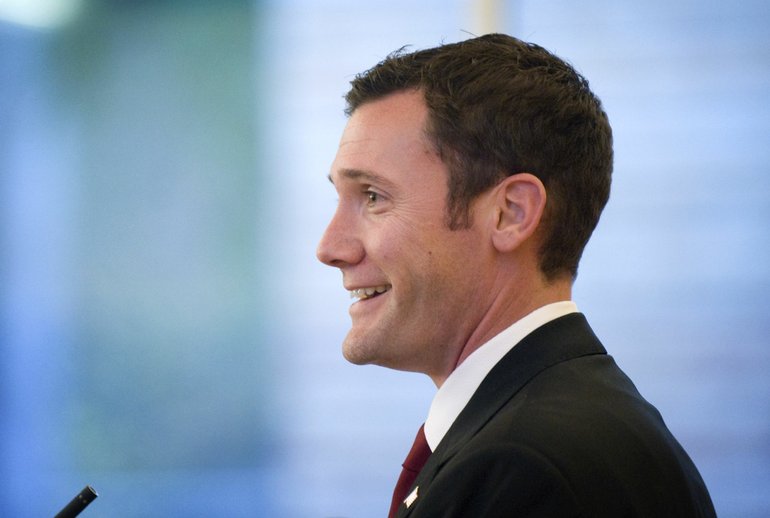Mayor-elect lays out plan for financing costly project
Vancouver mayor-elect Tim Leavitt, whose anti-tolling message helped propel him to victory last month, now says he would support tolls for a new bridge across the Columbia River — just so long as local commuters don’t have to pay it.
Under a new blueprint for financing the multibillion-dollar project, Leavitt said his version of a toll would exempt local commuters and businesses. Doing so would clear about half of the motorists who cross the Interstate 5 Bridge daily, leaving out-of-area truckers and tourists to pick up the “local” share of the $2.6 to $3.6 billion project.
“I’m trying to represent the businesses and commuters for the city of Vancouver,” Leavitt said in an interview Friday. “To the extent I can fight for relief from tolling, that’s what my job is.”
Leavitt, a Vancouver city councilman, currently serves on the proposed crossing’s 10-member Project Sponsors Council as C-Tran’s representative. In January, Leavitt will move into the seat on the council currently occupied by outgoing Vancouver Mayor Royce Pollard.
Leavitt defeated Pollard on Nov. 3, largely because of his stated opposition to bridge tolls.
Vancouver’s city government has no authority over tolling — the state Legislature authorizes tolls, and the state Transportation Commission sets the rates. However, Leavitt’s campaign rhetoric begged the question: If he didn’t support tolls to raise the local share of the project, what did he support?
Over coffee before a downtown tree-lighting ceremony on Friday, Leavitt laid out his vision.
“Everyone agrees that an improvement needs to happen,” he said. “That’s a no-brainer. The only real stickler is the financing plan.”
Leavitt’s plan would generate about $600 million in revenue from tolling, roughly half the $1.3 billion that project planners anticipate from tolling.
To get to $3.6 billion, Leavitt assumes Oregon and Washington’s legislatures would each contribute $500 million.
He also assumes the 10-member Project Sponsors Council will accept $650 million in project cutbacks proposed by engineers. The proposed cutbacks include narrowing the bridge from 12 lanes to 10.
Most significantly, Leavitt’s funding scenario assumes a major increase in federal funding.
Because congestion on Interstate 5 represents a major choke point on the federal interstate system, Leavitt says it’s fair to expect the federal government to pick up $2 billion of the cost of repairing it. The project would replace the existing drawbridges, improve five miles of freeway interchanges and extend light rail to Clark College.
A new federal economic stimulus bill could do the trick, Leavitt said.
“All this heartache we’ve been dealing with could be wiped away with the stroke of a pen by President Obama,” he said.
Crossing officials believe the project is well-positioned to receive $750 million in federal transit funding for the light rail extension. In addition, U.S. Sen. Patty Murray, D-Wash., has said the project could receive another $400 million in federal highway funding.
That leaves another $850 million in additional money from the feds, under the Leavitt plan.
Murray told The Columbian last year that it would be tough enough to come up with the $400 million in highway funding. That would be nearly double the biggest single allocation ever for a federally funded transportation project in Washington state.
“I would love to be Santa Claus,” she said, “and I’m not.”
On Monday, a Murray spokesman said it’s premature to speculate about a second round of economic stimulus funding.
“Senator Murray believes that the federal contribution that’s currently assumed for the project is fairly substantial,” spokesman Matt McAlvanah said. “Given the fiscal condition of the federal government, meeting that contribution will be a significant challenge.”
Important tool
Between 68 percent and 75 percent of vehicles crossing the bridge during peak commuting periods get on or off the freeway within five miles of the Columbia River, according to estimates by planners with the bi-state crossing office. A total of 135,000 vehicles use the bridge daily, and about half use it during the eight hours of peak demand.
Portland Mayor Sam Adams, who also sits on the Project Sponsors Council, argues that tolling is an important congestion-management tool by encouraging people to commute during off-hours, take carpools or ride a bus.
Adams’ office did not return a call regarding Leavitt’s vision.
Leavitt contends that, by narrowing the bridge from 12 to 10 lanes, engineers have provided a practical incentive for commuters to find alternatives that don’t clog the freeway with single-occupancy vehicles.
“If you reduce the size of the bridge, then the need to social-engineer people’s behavior with high toll rates is not justified,” he said.
But doling out exemptions isn’t so clear-cut, said Don Wagner, regional administrator for the Washington Department of Transportation. The tolls would guarantee the repayment of a bond sold by Oregon and Washington transportation departments. Exempting motorists complicates the financing.
“It basically takes revenue out of the equation,” Wagner said. “My concern is, when you start talking about a lot of exemptions, the people who issue you your bond rating for the debt get pretty nervous.”
He said bond rating agencies may issue a higher interest rate on the bond, effectively reducing the cash available to build the project. In any case, Wagner said, the tolls may not take effect until the project is finished in 2017 — at the earliest.
“I appreciate the fact that the mayor-elect is concerned about tolls, as are we,” Wagner said. “But it’s a little premature to be talking about who gets exemptions.”
Erik Robinson: 360-735-4551, or erik.robinson@columbian.com.



